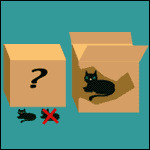Schrodinger's Cat
Created | Updated May 8, 2006

Erwin Schrödinger (1887 - 1961) was an Austrian physicist. He shared a Nobel Prize in 1933 for new formulations of the atomic theory. He was accused of being a cat-hater all his life, which is sad because in his own words he 'didn't really care either way'.
The Theory
The guiding principle of the Schrödinger's theory is that the two realms of physics; quantum mechanics and classical physics, do not have an easily definable separating border. In other words, the quantum effects that are thought to affect only small atomic particles, also affect much larger and more complex structures, such as human beings and cats.
What Schrödinger was showing was that while every physicist accepted that sub-atomic particles, like electrons, could be in more than one place at the same time (called superposition), no one believed that this could be extended to large things. Schrödinger showed that they were indeed subject to the same rules laid out by Heisenberg in his uncertainty principle and were also subject to superposition.
Schrödinger's thought experiment is effectively a domain issue. The domains of quantum mechanics and classical physics.
The Experiment
A cat is placed in a box. It should be pointed out that this is not a cardboard box, or a lead box. The box is a method of separating the cat from the observers. Placing the cat one light-hour away would perform the same function. Alongside the cat is a vial with a radioactive isotope and a Geiger counter linked via a complex device to a hammer over a vial of cyanide gas.
The isotope has a 50/50 chance of decaying during the course of one hour. If it does, the Geiger counter will go off, the hammer will smash the glass and the cyanide gas will kill the cat. The cat is put in the box for one hour, then the box is opened.
Since the quantum superposition of the isotope says that it is both decayed and not decayed until we look at it, and the box prevents us from knowing whether the isotope has decayed until we open it, it's impossible to know the fate of the cat. So until the box is opened and you look at a bemused Fluffy or the start of an awkward conversation with the wife, you can't tell what you'll find.
This happens because the isotope decay/non-decay creates a quantum probability wave. This is related to Heisenberg's Uncertainty Principle, which says that the position of any sub-atomic particle cannot be measured precisely, the best one can get is a probability wave function of its position. In other words an approximation to its position. This happens because sub-atomic particles can be in two 'states' at once. This is called superposition. For example, it can be in two locations, or in the same location but can be spinning in opposite directions at the same time. In fact, it can be in many states at the same time. Heisenberg proved that this was true and not a contradiction1. He also showed that the particle falls into one of its possible states only when it is measured, eg looked at. Thus, before measurement, the particle's position cannot be described easily. The solution to this was the probability wave function, which describes every possible location and 'spin' of the particle, along with a probability that the particle will be in that location.
The probability wave function for the isotope says it is decayed and non-decayed, because of the 50/50 chance, and that both waves exist at the same moment, and only when you open the box and look in, does one wave collapse (it is reduced to a probability of zero) and the other becomes established as the result. This means that the cat also has a quantum probability wave (although scientists argue whether it has its own wave or simply shares the isotope's one), which means that the cat exists as a dead cat and a living breathing cat, at the same time.
The problem is that until you look in the box, the isotope is both decayed and not-decayed, and as its fate is linked, the cat is both dead and not-dead. At the same time. This is not the same thing as saying that the cat's fate is unknown, or that the cat is half dead. The cat is dead and non-dead (alive) at the same time.
Science has yet to determine if the cat exists in both states or if two 'pseudo'-cats exists in the box. The theory raised a lot of eyebrows, particularly in the clergy, because it suggests that not even God can know the fate of the cat until the box is opened (assuming you ban him from using time travel).
The Conclusion
Macroscopic2 quantum superpositions3 exist (possibly).
Schrödinger effectively demonstrated that there is no 'nice' barrier between the quantum and classical physical worlds. The quantum affects even very large things, like cats.
It would be irresponsible to present this argument as fact. There are other interpretations of the experiment. There is argument about when the reduction of the quantum probability wave happens. At the point of observation is one theory, but others have suggested less subjective possibilities.
For more information on superposition and sub-atomic weirdness, visit The Copenhagen Interpretation.
The Jokes
As every cat owner knows, the cat has three states; alive, dead and bloody furious.
And of course; the cat always dies because the box in every diagram has no air-holes.
Having dated physicists, this Researcher can confirm they all own cats.

